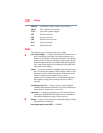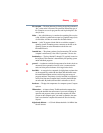
244
Glossary
non-system disk — A disk for storing programs and data that cannot be
used to start the computer. Compare system disk.
O
online — Available through the computer. Online may refer to
information being read from your own computer’s hard disk, such
as online documentation or online Help, or to information coming
from another company on a company network or the Internet.
operating system — A set of programs that controls how the computer
works. Examples of operating systems are the Windows
®
XP Tablet
PC Edition and Windows
®
XP Home operating systems.
optical drive — A drive which reads plastic coated discs on which
information is recorded digitally, and uses a laser to read data,
music, or videos.
P
palette — See color palette.
parallel — Processes that occur simultaneously. In communications, it
means the transmission of more than one bit of information at a
time. On your computer, the parallel port provides a parallel
communications interface between the computer and an appropriate
device. Most modern printers are parallel. Compare serial.
password — A unique string of characters entered by a user to verify his
or her identity to the computer or the network.
PC Card — A credit-card-sized expansion card designed to increase the
capabilities of notebook computers. PC Cards provide functions
such as modem, fax/modem, hard disk drive, network adapter,
sound card, or SCSI adapter.
peripheral — Any device, such as a printer or joystick, that is attached
to the computer and controlled by the computer’s CPU.
pixel — Short for “picture element.” The smallest dot that can be
produced on a screen or printer.
Plug and Play — Generally, refers to the computer’s ability to
automatically configure itself to work with peripheral devices.
When capitalized, refers to a standard that, when followed by a
device manufacturer, allows a computer to configure itself
automatically to work with the device.
pointing device — Any device, such as the TouchPad or a mouse, that
enables you to move the cursor on the screen.


















